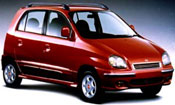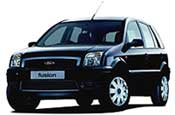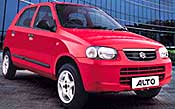Auto industry on the fast track
By Mohini Bhatnagar | 04 Jan 2005
The boom of 2004 can be surpassed in 2005 if the government introduces VAT and lowers excise.
Its been a landmark year for the Indian auto industry. For the first time, total sales (exports and domestic) of passenger vehicles — cars, utility vehicles and multi-purpose vehicles — in the country exceeded the 1-million mark. Sales grew 32.20 per cent in 2003-04 to around 1.03 million units. This comprised 9,00,752 units in domestic sales and 129,316 units of exports (source: Society of Indian Automobile Manufacturers {SIAM}).
During 2004 the Indian auto components industry's exports touched around Rs1 billion. According to McKinsey's latest report, this sector of the auto industry has the potential to achieve exports of $25 billion (Rs1,15,750 crore) over the next decade..
The domestic auto market, which grew by nearly 30 per cent in the last financial year, is expected to exceed this figure substantially before the financial year closes on March 31, 2005. Upbeat about growth prospects several auto companies announced major vehicle launches and extensive capacity expansion plans for the future.
Investments and capacity expansions
A number of companies have announced substantial capacity expansion as well as investments in R&D. According to SIAM, automotive vehicle manufacturers are expected to invest a whopping Rs25,000 crore in the Indian market from 2005 to 2010. Of this, about Rs10,000 crore will be on research and development and the rest likely to be largely on capex.
On an average, this translates into an investment of about Rs5,000 crore every year for the next five years, compared to the total investment of around Rs1,708 crore for 2002-03.
 MUL with parent company Suzuki Motor Corporation announced a Rs6,000-crore investment plan while Hyundai, which is expanding capacity at its Tamil Nadu plant has also indicated the possibility of setting up a new unit, as have Toyota, Honda, General Motors, Mahindra & Mahindra, and Tata Motors.
MUL with parent company Suzuki Motor Corporation announced a Rs6,000-crore investment plan while Hyundai, which is expanding capacity at its Tamil Nadu plant has also indicated the possibility of setting up a new unit, as have Toyota, Honda, General Motors, Mahindra & Mahindra, and Tata Motors.
The scenario is similar in the auto components sector. Officials from the Automotive Component Manufacturers Association (ACMA) say investments on capex by automotive component companies would be around Rs 2,000 crore on an annual basis working out to about Rs10,000 crore over the next five years.
Key investments in the components sector include the proposed Rs1,000-crore investment by Bosch, Rs350 crore by Bharat Forge, Rs200 crore by Goetze India and Rs125 crore by Sona Koyo Steering Systems, among others.
A recent study by McKinsey says exports of auto components from India could be in the region of $20-25 billion by 2015.
 Meanwhile, automotive vehicle manufacturers such as Hyundai, Maruti, and Tata Motors are already using substantial proportions of their current capacities for exports.
Meanwhile, automotive vehicle manufacturers such as Hyundai, Maruti, and Tata Motors are already using substantial proportions of their current capacities for exports.
Two companies, Suzuki Motor Corporation of Japan and Hyundai Motor Company of Korea, have indicated that their Indian manufacturing facilities will be used as a global source for small cars. There are also other indicators that the automobile sector has the potential and opportunity to become a global producer of small cars.
This is more than likely since the Indian passenger car industry has matured and reached critical mass in terms of number of vehicles it sold and quality. The spurt in in-house product development skills and the uniquely high concentration of small cars in India will influence the country's ability to become a sourcing hub for sub-compact cars.
The high level of investment in the small car segment and the strengths built up in the segment can be leveraged to achieve higher export volumes of such vehicles. This will particularly benefit domestic companies as the overseas market for sub-compacts is also growing, though at a slower rate than the domestic market.
India can ideally follow Thailand's example. Thailand has emerged as a global production base for utility vehicles. The Thai automobile industry has been developing for the past 25 years, with a major chunk of investments in components manufacture and vehicular assembly line production coming only in the last decade. As a result, GM, Ford and Toyota have set up large manufacturing facilities in Thailand manufacturing pick-up trucks, sports and multi-utility vehicles with the result that Thailand is now one of the largest manufacturing bases for such vehicles outside of the US and the largest market for utility vehicles.
During the last decade, the market for small cars has been concentrated in the Asian region, with pockets of demand coming in from Latin America and Europe. With the expansion of the European Union and the increased vehicular emission concerns in Western Europe about vehicular pollution and the need for cars with better fuel economy, India's small cars are expected to become more popular there.
Passenger car launches 
The new vehicles launched in 2004 included the premium segment Hyundai Elantra (luxury sedan), the crossover vehicle Hyundai Getz, multi utility vehicle Chevrolet Tavera, the new Qualis from Toyota, the 'C' segment Fiat Petra (sedan), the Indigo Marina, station wagon variant of Indica from Tata Motors and the Ford Fusion.
2004 also saw a number of passenger vehicles being imported as completely built up units or CBUs. These include the Rs5-crore Maybach from Daimler Chrysler, the Skoda Superb, a new variant of the Mitsubishi Pajero, the Toyota LandCruiser Prado, the Nissan X-Trail, luxury sports car Bentley Continental GT, and new models of BMW.
In an indication of the growing importance of the Indian auto market, most new model launches coincided with their global launch.
Some launches for 2005 include Toyota Motor's IMV Toyota Innova in the first half of 2005 while Hyundai Motor India has announced the launch of its crossover vehicle Matrix and sports utility vehicle (SUV) Tuscan in 2005. General Motors plans to launch the Spark while Maruti Udyog is planning to launch the 1.3-litre Swift.
While these cars belong to the 'B' and 'C' segments, other high profile super premium vehicles are soon going to hit Indian roads. Volkswagen Group company, Audi, has announced its plans to launch three models by the middle of 2005, while French company Porsche is bringing in the Carrera and two other models. Fiat India, enthused by big ticket launches of Audi and BMW, is said to be planning the launch of Alfa Romeo in the coming year. All these will be brought in as CBUs, thus hiking up their prices due to the steep duty structure.
Industry officials point out that an indication of the maturing of the market in 2004 was the increasing acceptability and desire for passenger vehicles other than stately looking sedans. The inordinate success of the spacious and ruggedly built SUVs paved the way for the entry of crossover vehicles like the Ford Fusion and the Hyundai Getz while Hyundai Matrix is due to be launched during the year.
According to Vinay Piparsania, vice president sales and marketing, Ford India, these vehicles combine the spaciousness and ruggedness of SUVs with the elegance of compact cars.
To spur sales in 2004, automakers resorted to the largest number of price cuts ecer. The launch of the new Honda City in late 2003 priced between Rs6 lakh and Rs8 lakh changed the positioning structure of the market.
The success of the new Honda City led to rival carmakers resorting to introducing lower tag variants to capture the volume surge. General Motors launched the 1.6-litre Optra directly against City. MUL launched a new Baleno Lxi variant at Rs5.6 lakh with no change in engine or power. MUL also lowered the Esteem's price to below Rs5 lakh. GMI, too, slashed the price of the Corsa to below Rs5 lakh.
The year also witnessed declining sales of the Maruti 800, heralding the beginning of the end of the entry level vehicle from MUL and its bread-and-butter model, which had single-handedly turned MUL into India's largest automobile company with more than 75 per cent market share a decade ago. The 800's sales began falling two years ago and the company began pushing the model aggressively in small towns and villages, positioning it as price warrior. Passenger cars in the 'B' segment have, now emerged the new entry-level models.
 Clearly, 2004 belonged to sub compact or 'B' segment cars like Maruti Alto, Tata Indica, Maruti Zen, Hyundai Santro, Maruti Wagon R, Fiat Palio and GM Corsa Sail, which grew by 23.4 per cent to 3,69,537 units in 2003-04 up from 299,359 in the previous year. Another segment that saw tremendous growth (though from a smaller base) in the year was the executive segment (consisting of cars such as the Skoda Octavia and the Toyota Corolla), which grew almost seven times to 14,337 units in 2003-04.
Clearly, 2004 belonged to sub compact or 'B' segment cars like Maruti Alto, Tata Indica, Maruti Zen, Hyundai Santro, Maruti Wagon R, Fiat Palio and GM Corsa Sail, which grew by 23.4 per cent to 3,69,537 units in 2003-04 up from 299,359 in the previous year. Another segment that saw tremendous growth (though from a smaller base) in the year was the executive segment (consisting of cars such as the Skoda Octavia and the Toyota Corolla), which grew almost seven times to 14,337 units in 2003-04.
The way ahead for 2005 lies in the government carrying forward the process of reform. Industry analysts believe the implementation of VAT as well as the lowering of excise duty on automobiles to 16 per cent would further provide an impetus to the industry. Dampeners would be hiking of steel prices and petroleum prices both of which are uncertain factors.













.jpg)






.jpg)









